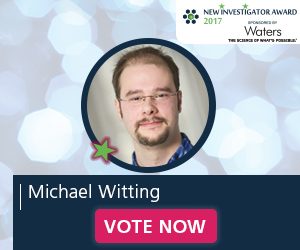New Investigator Award Finalist: Michael Witting

 Find out more about the other finalists
Find out more about the other finalists
Comments from voters:
- “Michael Witting is an excellent scientist, loves technological challenges and to make full use of its researchers’ potential without discrimination. The vital role about the advantages of interdisciplinary collaboration with a network of partners he has already been successfully practiced.”
- “Michael Witting is a dedicated researcher who was and is involved in a number of remarkable studies. He is not only busy in the metabolomics field, but he is also interested in the connections to transcriptomics and proteomics. I think that this point is crucial for good science and that this makes him an outstanding researcher.”
- “Michael Witting’s research is important in moving the field of metabolomics forward and has done a great job disseminating his techniques to others. His research is novel, timely, and addresses key issues using new techniques.”
Follow Bioanalysis Zone on twitter, facebook or LinkedIn to be the first to find out the winner!
What made you chose a career in bioanalysis?
I studied chemistry, but I have always been interested in biological sciences. This resulted in a specialization to biochemistry, but with a strong focus to analytical chemistry and its application in biological research. I conducted my diploma thesis in the Laboratory of Bioanalytical Chemistry at the University of Applied Sciences Nuremberg, Germany and finally moved fully into this field with my PhD thesis in metabolomics at the Research Unit Analytical BioGeoChemistry. Ever since this I enjoy the work with people from different research fields who seek to apply bioanalytical methods in collaboration with me to their specific problems.
Describe the main highlights of your bioanalytical work?
During my PhD I developed and applied extraction and analysis methods for C. elegans samples and applied them to a C. elegans – P. aeruginosa infection model. Several publications resulted from the obtained data (Wägele et al. 2013, Witting et al. 2015, Witting et al. 2014, Witting et al. 2017).
A special focus was the use of DI-FT-ICR-MS as fast metabotyping tool. Based on the obtained metabolic snapshots I was not only able to separate worms infected with P. aeruginosa PA14 from control worms, but also the attenuated ∆gacA mutants from the fully virulent wildtype and from S. enterica infection and starvation as additional measures of stress. This method can now serve as a new tool in screening in infection biology using C. elegans as model host and metabolism as functional readout. The short analysis time of <10 minutes per sample enables a high throughput (HT). Furthermore, for measurement the metabolite extracts have to be diluted to an equivalent of 20 worms / mL, which enables the use of lower biomass and is an additional important point for the integration in HT studies.
How has your work impacted your laboratory, the bioanalytical field and beyond?
I developed several methods, which are now implemented in the laboratory as SOPs, e.g. for analysis of metabolites and lipids using UPLC-UHR-ToF-MS. Although originally developed for the analysis of the C. elegans metabolome and lipidome, these methods have been proven to be also applicable to many different biological matrices. Three distinct separation methods (HILIC, RP and RP for lipids) cover a large range of metabolites. Together with tailored sample preparation methods they can be easily adopted to different bioanalytical needs from different collaboration partners or own C. elegans samples. This comprehensive analysis platform is getting more and more recognized by different researchers, especially in the C. elegans field and is applied to different projects, e.g. analysis of infection models, Alzheimer’s and Parkinson’s disease models or large scale functional screening.
Describe the most difficult challenge you have encountered in your scientific career and how you overcame it?
One particular challenge was to find an own topic for my future research. I wanted to further develop myself and apply the skills I have learned during my diploma and doctoral thesis to new bioanalytical problems. However, I also wanted to differentiate myself from my supervisors. During my doctoral thesis, I was working for the first time with C. elegans and I realized that the combination of a genetic tractable model organism like the worm with metabolomics is a fruitful combination.
Even up to the present day not many laboratories combine these two. Therefore, I decided to focus on C. elegans metabolomics as my future main topic. In 2013 I was searching for new collaboration partners within this topic to strengthen my scientific profile and enable myself to learn more about the worm’s biology. My collaboration with Dr. Hugo Aguilaniu is among one of the most fruitful established links and I successfully acquired funding from the DAAD for scientific exchange with the Aguilaniu lab at the ENS in Lyon. During research visits at this lab I learned all necessary techniques to set up my own C. elegans cultivation facilities and by this I gained independence.Describe your role in bioanalytical communities/groups?
I’m an active member of the computational metabolomics task group of the Metabolomics Society, as well as member of the Gesellschaft deutscher Chemiker (German Chemical Society) and its groups “Fachgruppe Analytische Chemie” and “Arbeitskreis Separation Science” and the “Deutsche Gesellschaft für Massenspektrometrie” (German Mass Spectrometric Society) and its group “LC-MS”. As organizer of the upcoming workshop on C. elegans metabolic reconstruction and metabolomics I’m trying to teach interested scientist and raise their awareness of bioanalytical approaches and possibilities for the analysis of the C. elegans metabolome. I’m working in international teams with collaboration partners from different countries and different fields in biological sciences, mainly in different aspects of C. elegans research, but also other topics and regularly attend international bioanalytical conferences. Despite my different collaborations, I’m reviewing for different analytical and bioanalytical journals and I’m a special issue guest editor together with Dr. Christophe Junot for a Journal of Chromatography B special issue on “Unknown identification from non-targeted analysis”. Since 2015 I’m teaching undergraduate and graduate students in bioanalytical methods and metabolomics and supervised bachelor and master students, as well as co-supervised several PhD students in regard to LC-MS based metabolomics and metabolite identification.
List up to five of your publications in the field of bioanalysis:
1 DI-ICR-FT-MS-based high-throughput deep metabotyping: a case study of the Caenorhabditis elegans-Pseudomonas aeruginosa infection model. Witting M, Lucio M, Tziotis D, Wägele B, Suhre K, Voulhoux R, Garvis S, Schmitt-Kopplin P. Anal Bioanal Chem. 2015 Feb;407(4):1059-73. doi: 10.1007/s00216-014-8331-5. Epub 2014 Nov 27.
2 Ion mobility as additional separation dimension to tackle the complexity of the Caenorhabditis elegans lipidome A. Laurençon, J. Thiemann, V. Gnau, J. Uhl, H. Aguilaniu, M. Witting. HPLC 2017, Oral Presentation
3 Optimizing a ultrahigh pressure liquid chromatography-time of flight-mass spectrometry approach using a novel sub-2μm core-shell particle for in depth lipidomic profiling of Caenorhabditis elegans Witting M, Maier TV, Garvis S, Schmitt-Kopplin P.
4 Steroid hormone signalling links reproduction to lifespan in dietary-restricted Caenorhabditis elegans. Thondamal M, Witting M, Schmitt-Kopplin P, Aguilaniu H. Nat Commun. 2014 Sep 11;5:4879. doi: 10.1038/ncomms5879.
5 The Role of Dafachronic Acid Signaling in Development and Longevity in Caenorhabditis elegans: Digging Deeper Using Cutting-Edge Analytical Chemistry. Aguilaniu H, Fabrizio P, Witting M. Front Endocrinol (Lausanne). 2016 Feb 11;7:12. doi:10.3389/fendo.2016.00012. eCollection 2016.


